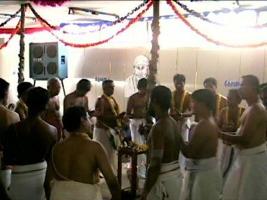Divyanama Bhajan

The Process of Deepa Pradakshinam:
Deepa Pradakshinam is widely spoken as Divyanaamam. As the entire Paddhathi is full of Lord's Divya Naamam, it is preferable to call this Paddhathi as Deepa Pradakshinam instead of Divyanaamam. Therefore, wherever the word Divyanaamam appers hereafter, please read it as Deepa Pradakshinam. Once we have the vision of God (through Paddhathi Bhajan), our philosophical knowledge gets ripened and then we are able to go near God and make friendship by dancing in ecstasy, enacting God's Leela and be in his company (Deepa Pradakshinam). Once we are fixed thus in our Bhakthi, we forget our worldly self and enjoy full bliss but our Ego does not get annihilated.
It only gets converted from Rajasic Ego (based on our materialistic attachments) to Saathwic Ego (possessiveness of God - based on our philosophical attachment). Now God helps us to cast away this Positive Ego also by disappearing for a while to make us realise the importance of His presence. Then when we lament, realising the truth (Gopikaa Geetham), and totally surrender to Him (Saranaagathi song), Lord appears and mingles with us in (Raasa Kreeda songs), whereby he makes us realise that God is present in every human being unattached and unbound and He again shines separately as the center of activity. Finally we try to merge with God (Dolothsavam).The process prescribed by our scriptures for attaianing this is beautifully brought out by the following sloka:
Meaning:
The process of repeatedly hearing the deeds of God (SRAVANAM), doing Japam or singing in praise of HIM (KEERTHANAM), dwelling in His Leelaas (SMARANAM) Pouring Bhakthi onto His feet and serving him (PAADA SEVANAM), performing pooja (ARCHANAM), prostrating before him (VANDANAM), Serving him without Ego (DAASYAM), gaining his friendship (SAKHYAM), surrendering totally unto HIM (AATHMA NIVEDANAM) is aimed at the culmination of human evolution (Mukthi).
While in Paddhathi Bhajan, Bhagavathaas sit and sing the bhajan , in Deepa Pradakshinam, there is also an additional element, where Bhakthaas dance (Nrithya) and enact the leelaas of the Lord (Abhinaya) around the lit Brass lamp (five faceted). In the present day situations, Deepa Pradakshinam is performed on Saturdays, special occasions like Saturdays of Purattasi month, Gokulashtami, Ramanavami etc. The Lord from Sanctum is brought to the lamp in the form of Jyothi (by Aavaahana Manthram). We do Deepa Pooja and place the lamp in the center of the hall and sing in praise of Him. Bhakthaas, along with the songs, enact the leelaas of God by dancing around the Pancha Mukha Deepam (placed in the center of the hall), in tune with the meaning of the song. This is to enable one to concentrate on the theme and forget one's self during Deepa Pradkshinam and try to tune up with the Godly principle. It is also necessary to precede special Bhajan with Paddhathi Bhajan, which is the basic Paddhathi for all other systems. DEEPA PRADAKSHINAM, compared to Paddhathi Bhajan, gives more chance for participation by one and all either in singing, dancing, abhinaya etc. , wherein we forget ourselves and feel the presence of the Lord amongst us and prepares us to have Samabhaavana as we are able to mix up with other Bhakthaas/Bhagavathaas without ego.
- Achala Bhakthan .